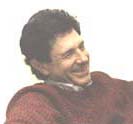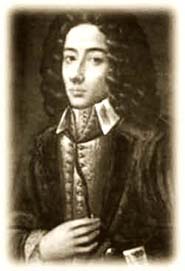 B U X T E - W H O ? B U X T E - W H O ?
Two years ago Dieterich BUXTEHUDE
surfaced on my SymphonySpace/Thalia Theater
cello concert as a visiting, improvising keyboard "superstar" at a harpsichord
festival
in Bruges, Belgium. He was part of a semi-fictional retelling of the origins of Bach's
Lute
(-klavier) /Cello Suite No. 5 in c minor
dedicated to a harpsichord maker, M. Schouster.
Now here he is again, in an all-Buxtehude organ recital stunningly played by
Walter
Hilse at New York's Saint Peter's Church
on September 29, 2007. Only in New York,
where all-Bach programs are fairly common, would an all-Buxtehude concert take place
(it happens to be the 300thAnniversary of his death) and draw a sizeable audience.
And
only in New York would such a wonderful occasion, such a monumental achievement,
be totally ignored by the one remaining "major" newspaper.
I come to a concert like this one from the perspective of the string player, of the
cellist,
and there is much to be learned here, to take with you from such an experience. I
shall
leave the fine points of organ technique and of Buxtehude's standing in the hierarchy
of the all-time great composers to the specialists, and rather focus on the larger
impact
of such an occasion.
Buxtehude's reputation and his spell over the 20-year old Bach were so strong that
Bach, then the organist at Arnstadt, was granted
a leave of absence from his post to
walk (!) the 290 miles to Luebeck (northeast of
Hamburg) and hear the great organist.
Albert
Schweitzer, himself a great organist, tells
the story, in his Bach biography, of
Bach being so entranced by the older master that he overstayed his leave by two
months, literally "playing hooky" from his post.
Leopold Stokowski, that talented
showman-conductor of the recent past, brought
Bach's gigantic Toccata and Fugue in d minor
to the masses via Walt Disney's film
"Fantasia"
in an arrangement for the full modern orchestra. Had Stokowski (who.
incidentally, began his career as an organist in London) heard Walter Hilse's grand
conception of the opening work, Buxtehude's Magnificat primi toni, or the closing
Preludium in e minor, he might have been tempted to present this music as well in
an
orchestral arrangement for our time. And Brahms, very interested in baroque music,
was overwhelmed by Buxtehude's Passacaglia in d minor (also performed by Hilse
on this same occasion), when his friend Phillip Spitta, the
famous Bach biographer,
gave him the score.
Bach's Suites, Sonatas and Partitas for solo cello and solo violin are, of course,
the
mainstay of our repertoire and the source of endless performance controversy. In
his
Chorale Partita " Auf meinen lieben Gott," also played at the concert,
Buxtehude took
a chorale melody as the basis of a five-part French dance suite.
We are all familiar
with the titles Allemande, Double, Courante,Sarabande and Gigue from the Bach suites.
It is quite intriguing to hear Buxtehude's treatment of these idealized dance forms.
Coming a little closer to our time: the Spanish cellist-composer-arranger Gaspar
Cassadó, Pablo Casals'
most famous pupil, composed a Toccata in the style
of the Italian
Frescobaldi. Frescobaldi was
himself of great influence on the North German composers
such as Buxtehude and Bach. To learn to play this magnificent fantasia on the cello
with the expansiveness that it deserves, it is very helpful to hear such music played
on the organ.
As cellists, as string players, we tend to take for granted the enormous range of
shadings,
colors that can be drawn from our instruments. All the more amazing to hear the
imaginative use of registration that Walter Hilse applied to the responsive Klais organ at
St.Peter's Church, creating the illusion of a coloristic rainbow. We, who face our
audience
when performing, also tend to take for granted the opportunity for eye contact with
the
listeners. The organist, when not buried in the loft, sits at his console with his back to the
audience throughout. Mr.Hilse managed to overcome this handicap by bobbing and
weaving and by conveying great kinetic energy and intensity by means of his visually
compelling bodymovements.
At the end of this rewarding and engrossing recital Walter Hilse received a long
standing
ovation from the grateful audience, myself included.
POSTED: NOVEMBER 15, 2007
COPYRIGHT AND TRADEMARK
This blog created, written and maintained by Harry Wimmer (hwimmer@wimmercello.com).
Thanks to Shirley Givens
sgivens@juilliard.edu for her imaginative illustrations. |
Design and content ©2006-2012 by Harry Wimmer, Incidental Artwork
©2006-2012 by Shirley Givens.
All materials on this blog are limited to personal, non-commercial use.
CelloBlogTM
Trade Mark by Harry Wimmer |
|
 OTHER
POSTS OTHER
POSTS
Django
in Cajun Country
Sir
Michael Tippett in Carnegie Hall
Confessions of a Would-be Page Turner
Charlie Chaplin - Left-Handed
Cellist and Composer
The
Concert As A Meal
The
N.Y.Times Misses Out Again! Quack!
 ARTICLES,
CARTOONS ARTICLES,
CARTOONS
The Virtuoso
by Wilhelm Busch
The
Cello Concerto (anon.)
Young
Itzhak Perlman in Aspen
Leonard
Rose in Colo.Springs
String
Portraits by Shirley Givens
Bach's
C Minor Suite Was Written This Morning.
Pablo
Casals From Afar
Michael
Tippett Arrives in Shorts Shorts
Casals
Lives On in Puerto Rico
The
Golden Treasure of San Juan
Bach on the Bayou
HARRY WIMMER ON 
BRAHMS:
Sonata in E Flat Op.120 No.2 (Live)
MENDELSSOHN: Sonata No. 1 in B Flat (Live)
CHAPLIN-WIMMER: "Oh, That Cello! (Live)
MENDELSSOHN-CASALS:
Spring Song (Live)
 ABOUT
HARRY WIMMER ABOUT
HARRY WIMMER
Bio
from the"Joy of Cello Playing" site |


